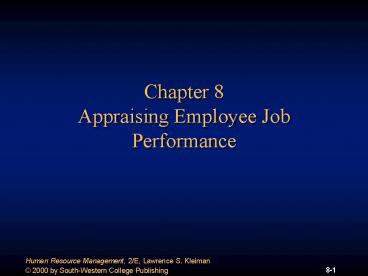Chapter 8 Appraising Employee Job Performance - PowerPoint PPT Presentation
1 / 34
Title:
Chapter 8 Appraising Employee Job Performance
Description:
2000 by South-Western College Publishing. Human Resource Management, 2/E, Lawrence S. Kleiman ... Failure to document job performance throughout appraisal period ... – PowerPoint PPT presentation
Number of Views:432
Avg rating:3.0/5.0
Title: Chapter 8 Appraising Employee Job Performance
1
Chapter 8Appraising Employee Job Performance
2
HRM and Competitive Advantage
HR Planning Job Analysis
Recruitment Selection
Output Retention Legal Compliance Company Image
Competence Motivation Work Attitudes
Cost Leadership Product Differentiation
Training/Develop. Performance App. Compensation Pr
oductivity Imp.
Workplace Justice Unions Safety
Health International
3
Linking Performance Appraisal Practices to
Competitive Advantage
Strategic Plan
Direct Behavior Correct Behavior Monitor Behavior
Improved Job Performance
Effective Performance Appraisal System
Input Into Employment Decisions
Improved Employment Decisions
Competitive Advantage
Perceived Fair And Accurate Process
Minimized Litigation And Job Dissatisfaction
4
Standards for Effective Performance Appraisal
Systems
- Quality of the rating form
- Accuracy of the ratings
- Legality of process and decisions
5
Quality of the Rating Form
- Relevance
- Clear performance standards
6
Performance Appraisal Relevance
Criterion deficiency
Criterion contamination
Relevance
7
Accuracy of the Ratings
- Leniency and severity errors
- Central tendency error
- Halo effect
- Raters use of implicit personality theory
- Recency error
8
Causes of Leniency and Severity Errors
- Political
- Lack of conscientiousness
- Vague performance standards
9
Causes of Central Tendency Error
- Administrative procedures
- Poorly defined scales
10
Causes of Halo Effect
- Lack of conscientiousness
- Vague performance standards
11
Causes of Raters Use of Implicit Personality
Theory
- Cannot observe all aspects of employees job
performance - Categorizing employees by type of person
12
Causes of Recency Error
- Memory decay
- Failure to document job performance throughout
appraisal period
13
Legality of Process and Decisions
- Disparate treatment
- Appropriateness of safeguards
- Disparate impact
- Job-relatedness
14
Types of Rating Systems
- Employee comparison systems
- Graphic rating scales
- Behaviorally anchored rating scales
- Behavior observation scales
- Management-by-objectives
15
Employee Comparison Systems
Paired Comparison
Simple Ranking
Robert Sally Fred Mike Ö
Ö Ö Robert Ö
Ö Sally Fred Ö
1. Mike Winkle 2. Robert King 3. Sally Morris 4.
Fred Taft
Forced Distribution
Low Average High 10 80 10
16
Ranking Methods
- Strengths
- Low cost
- Practical
- Time efficient
- Eliminates some rating errors
- Aids decision making
- Weaknesses
- Accuracy and fairness questionable
- Fail to direct or monitor behavior
- Cross-departmental comparisons difficult
17
Graphic Rating Scale
Unsatisfactory Satisfactory
Outstanding Quantity Ö of work Quality
Ö of work Dependability Ö
18
Graphic Rating Scales
- Strengths
- Low cost
- Practical
- Single form applicable to all or most jobs in
organization
- Weaknesses
- Accuracy questionable
- Fail to direct behavior
- Nonspecific job performance feedback
19
BARS Dimension Quality of Group Member Input
5
Group member has read all agreed-upon material
Effective
4
Group member participates in discussions, though
not always prepared
3
2
Group member does little work and offers no
valuable ideas or feedback
Ineffective
1
20
Behaviorally Anchored Rating Scales
- Strengths
- Useful for directing and monitoring behavior
- Weaknesses
- Research has not substantiated its superiority
over other methods - Choosing one indicative behavior
- Time consuming to develop
21
Behavioral Observation Scale
1 2 3 4 5
almost never almost always
___1. Sets clear priorities for multiple
goals. ___2. Coaches subordinates
effectively. ___3. Breaks projects into doable
components. ___4. Develops subordinates
knowledge and skills. ___5. Listens to
employees concerns. ___6. Seeks decision input
from subordinates.
22
Behavioral Observation Scales
- Strengths
- Useful for directing and monitoring behavior
- Useful for providing specific feedback
- Weaknesses
- Time-consuming to develop
23
Management-By-Objectives
Goal Setting
Planning
Evaluation
24
Characteristics of Effective Goals
- Consistent with organizational objectives
- Specific and challenging
- Realistic and achievable
- Measurable
25
Management-By-Objectives
- Strengths
- Directing and monitoring behavior
- Performance standards are objective
- Practical and inexpensive
- Employee participation
- Weaknesses
- Does not specify behaviors
- Focus on short-term
- Factors outside workers control
- Standards vary
- User acceptance
26
Designing an Appraisal System
- Gain support for the system
- Choose the appropriate rating instrument
- Choose the raters
- Determine the appropriate timing of appraisals
- Ensure appraisal fairness
27
Step 1 Gain Support for the System
- Gain support of upper-level managers
- Seek employee input
28
Step 2 Choose the Appropriate Rating Instrument
- Practicality
- Cost
- construction
- implementation
- utilization
- Nature of job
- observations
- behavioral measures
- output measures
29
Step 3 Choose the Raters
30
360 Degree Feedback
superiors
outside observers
self-rating
peers
employee
customers
subordinates
31
Step 4 Determine the Appropriate Timing of
Appraisals
semi- annually
quarterly
annually
monthly
32
Step 5 Ensuring Appraisal Fairness
- Upper-level management review
- Appeals system
33
The Line Manager and Performance Appraisal
- Complete the ratings.
- Provide performance feedback.
- Set performance goals.
34
The HRM Department and Performance Appraisal
- Develop the appraisal system.
- Provide rater training.
- Monitor and evaluate the appraisal system.































